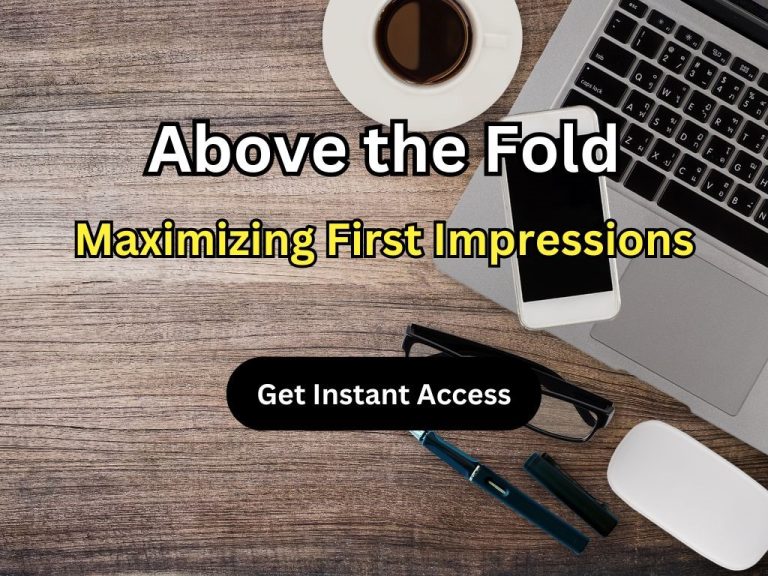What is Above the Fold?
You know when you click on a website, and within a second, you either stay or leave? That’s all about what’s above the fold, the part of the page you see before scrolling.
It’s kind of like walking past a coffee shop. If it looks inviting, maybe you step inside. If it’s cluttered or just doesn’t catch your interest, you keep moving. Same deal with websites. If the first thing you see makes sense and pulls you in, you stick around. If not, you’re gone before the page even loads completely.
People don’t have time to figure things out. So if a website doesn’t grab them right away, they won’t scroll down to see what they’re missing.
That’s why this part matters.
Key Takeaways
- The top section of a webpage plays a major role in engagement, SEO, and conversion rates.
- It originated from the newspaper industry, referring to the upper half of a folded newspaper that grabs attention.
- Modern web design emphasizes optimizing this section to enhance user experience and improve performance metrics.
- Placement of CTAs and essential information in this area boosts interaction and retention.
Why is Above the Fold Important?
User Engagement – Visitors decide within seconds whether they’ll stay on a site. A compelling top section increases engagement.
SEO & Bounce Rate – Google considers bounce rate a ranking factor. A well-optimized introduction reduces bounce rates.
Conversion Optimization – Placing key elements like CTAs (call-to-actions) in this area improves conversions.
Where Did “Above the Fold” Come From?
The term originated from the print newspaper industry. Newspapers were traditionally folded in half and displayed on stands, meaning only the upper half was visible.
Headlines and major stories were placed here to attract buyers. The digital world adopted this concept for web design, prioritizing the most crucial content at the top of a webpage.

How is Above the Fold Measured?
The exact location of the “fold” varies depending on screen size and device type.
On desktop screens, it’s generally the first 600 pixels, whereas on mobile devices, it can be around 300 pixels.
Responsive design ensures that important content remains visible across different devices.
Above the Fold in Email
In email marketing, the top portion refers to the section of an email that recipients see before scrolling.
This area is crucial for grabbing attention and encouraging recipients to engage with the content.
Just like in web design, ensuring key information is immediately visible can improve open rates and click-through rates.
Best Practices for Above the Fold in Email
- Concise Subject Line & Pre-Header Text: Ensure they communicate value quickly.
- Engaging Headline: The first line should be compelling and encourage further reading.
- Visible Call-to-Action (CTA): A clearly defined CTA within the first visible section can drive more conversions.
- Mobile-Friendly Design: Since many users check emails on mobile, optimize content for smaller screens.
Best Practices for Above the Fold Optimization
- Clear Headline: Use a concise, value-driven headline.
- Engaging Visuals: High-quality images or videos improve engagement.
- Call-to-Action: Place a compelling CTA where it’s immediately visible.
- Navigation & UX: Ensure intuitive navigation and fast loading times.
- Fast Loading Speed: Optimize image sizes and reduce unnecessary scripts to improve page speed.
Considerations for Mobile Devices
Since mobile users have smaller screens, the available above-the-fold space is more limited.
- Use minimal but impactful content.
- Ensure CTA buttons are easily clickable.
- Avoid pop-ups that obscure important information.
SEO Considerations
Google prioritizes user experience, meaning a poorly structured above-the-fold section can impact rankings.
- Reduce intrusive interstitials (such as pop-ups).
- Prioritize fast loading speeds using tools like Google PageSpeed Insights.
- Optimize text and images for clarity and quick scanning.
Optimizing Content & Ad Placement
Balancing content and advertisements is essential. Too many ads above the fold can harm user experience and Google rankings. Instead:
- Place ads strategically to avoid overwhelming visitors.
- Ensure content remains the focal point.
- Follow Google’s guidelines for ad placements.

Frequently Asked Questions (FAQs)
What does "above the fold" mean?
It refers to the section of a webpage visible without scrolling. It is a carryover term from print newspapers.
What is above the fold in email?
In email marketing, above the fold is the portion of an email visible before scrolling. It typically includes the subject line, preview text, and a key message.
How do you use above the fold in a sentence?
Example: “Make sure your call-to-action is above the fold so users can see it immediately.”
What does it mean for an ad to be above the fold?
It means the advertisement appears in the visible section of a webpage without the user needing to scroll.
What does "on the fold" mean?
“On the fold” generally refers to content positioned at or near the fold line, which may be partially visible before scrolling.
Alright, Here’s the Bottom Line
If the top of your site does its job, people stick around. If it doesn’t, they leave. Simple as that.
There’s no secret formula, no one-size-fits-all answer. Just test things, tweak what’s not working, and keep it clear. The goal? Make it easy for people to know what they’re looking at and why they should care.
That’s it. No overcomplicating. Just make it work.
To learn more check out our Marketing Glossary.



0 Comments